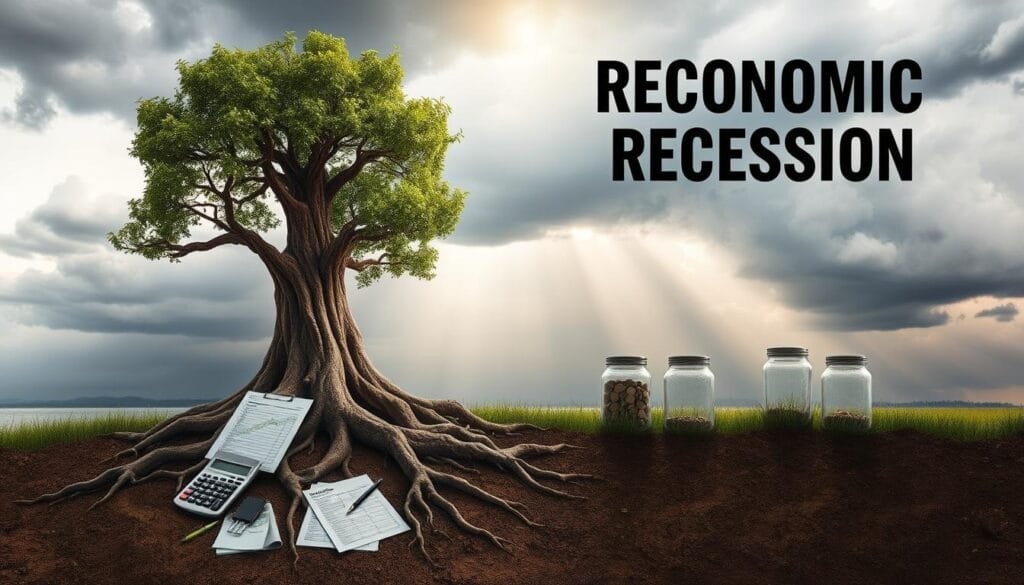Can we really tell when the next economic downturn will strike? This question is on many people’s minds, including economists, investors, and the public. Knowing how to forecast economic downturns is critical. It directly affects our financial futures. This guide explores how economic downturn predictions are made and looks at the details of recession risk analysis.
It’s crucial to understand and forecast economic shifts. These insights help us create effective business strategies and strengthen personal finances. Though predicting a recession might seem complex, having the right tools and knowledge allows us to make smarter choices. We will discuss key indicators, historical trends, and expert methods for anticipating downturns.
Key Takeaways
- Economic recession forecasts blend science and art, utilizing various indicators and models.
- Recession forecast accuracy extends beyond academia and impacts real-world financial planning and investment strategies.
- Understanding recession predictions helps mitigate financial risks and prepares businesses for downturns.
- The Conference Board Leading Economic Index (LEI) is a critical tool for anticipating economic declines.
- Historical patterns provide valuable insight but are not foolproof due to the dynamic nature of economies.
- Accurate economic downturn prediction can bolster both individual and organizational financial resilience.
With this knowledge, we can better understand economic recession predictions. Let’s explore the drivers of our economic foresight together.
Understanding Economic Recession Predictions
Predicting economic recessions is crucial for economists and policymakers. It helps us grasp the impact of economic downturns. This understanding is key to fighting economic instability.
What is an Economic Recession?
An economic recession means the economy is seriously slowing down for months. This slowdown is seen in GDP, income, jobs, and sales. Knowing what this means helps us spot trouble early.
Why Predicting Economic Recessions is Important
Making accurate recession predictions is crucial. They help us brace for job losses and less spending. Forecasting can save jobs, secure incomes, and keep businesses running.
Economists have sometimes predicted recessions accurately. For example, the Federal Reserve’s policies deeply affect economic health. Wrong policies can hurt the economy, as seen in the 2008 downturn.
In 2015, fears about China facing a severe downturn emerged. Yet, China didn’t enter a “Great Recession.” This showed the challenge of predicting economic troubles accurately.
Predicting recessions involves watching market trends, like falling interest rates. A key sign is the yield curve between short and long-term bonds shifting. It’s been a reliable recession indicator since the 1970s.
Probit analysis helps estimate recession risks by watching the yield curve. This method signals the need for early action. Tracking these risks is crucial for preparedness.
For economic stability, we must monitor and forecast accurately. The Conference Board’s Leading Economic Index uses ten indicators to foresee downturns. This Index has been a reliable recession warning since the 1970s.
By improving our understanding and predictions, we can better manage economic downturns. This reduces their impact on people and the economy.
Key Economic Indicators for Predicting Recessions
Knowing which economic indicators predict recessions can help us make smart decisions. The Conference Board Leading Economic Index (LEI) is key. It combines ten economic indicators. This gives us a look ahead at economic health.
The Role of the Conference Board Leading Economic Index (LEI)
The Conference Board Leading Economic Index (LEI) is vital for spotting economic trends. It looks at ten different indicators to get a full view of economic health. Before past recessions, the LEI often fell, hinting at trouble ahead.

Components of the Leading Economic Index
The LEI includes specific parts for their ability to show economic changes. Key components include:
- Average manufacturing hours
- Unemployment claims
- New orders in manufacturing
Certain indicators like interest rate spreads and stock prices are crucial too. They’ve been reliable at showing economic trends. By looking at these pieces, we can spot possible recession signs earlier.
Significance of Year-over-Year Percent Change
The LEI’s yearly percent change is critical. It evens out the month-to-month ups and downs. It gives us a stable view of long-term trends. When the LEI drops 5% from one year to the next, it usually means a recession is close. But despite dropping 5% in November 2022, there was no recession by January 2024. This shows our economy’s complexity.
Here’s a table that shows changes in the LEI and if a recession followed:
| Year | LEI Year-over-Year Change | Recession Within Next Year |
|---|---|---|
| 2001 | -5.2% | Yes |
| 2007 | -4.8% | Yes |
| 2022 | -5.0% | No |
The gap between GDP growth and LEI warnings shows why we need multiple indicators to guess recessions. Case in point: 4.9% GDP growth in Q3 2023 didn’t match the LEI’s prediction.
How Accurate Do You Think Economics Are at Predicting Recession
Economists often face criticism for their recession forecasts. They use tools like the Confederation Board Leading Economic Index (LEI), which signals market trends 1-3 months ahead. Still, their ability to predict long-term is questionable. Recent recession signals have sparked debate. Indicators such as the inverted yield curve and the Sahm Rule suggest we might be heading for trouble.
Historical Accuracy of Economic Predictions
Economic predictions have often missed the mark when it comes to recessions. Before the 2001 downturn, experts predicted a 2.5% growth. Instead, growth was almost zero. The Great Recession predictions were also far off, expecting 2.2% growth but seeing only about 0.6%.
A study examined 153 recessions in 63 countries from 1992 to 2014. It found that most downturns caught economists by surprise. This shows the challenge in predicting recessions accurately. Even the inverted yield curve, which can forecast recessions 6-22 months ahead, has its limitations.

Common Pitfalls in Predicting Recessions
Forecasts often fail due to overreliance on certain indicators and not accounting for unexpected events. The COVID-19 pandemic, for example, drastically changed economic dynamics. Also, long-term Treasury yield spreads can’t always predict beyond a year, making them less reliable over time.
The difficulty in forecasting comes from unforeseen market forces. For instance, the 2008 financial crisis predictions were way off, expecting a 2.6% GDP growth instead of the 3.3% contraction that occurred. Rate inflation predictions in 2022 were similarly inaccurate, with actual rates far exceeding forecasts. These examples underline the limits of current prediction models and the need for more adaptable methods.
In conclusion, despite the LEI and historical data offering some insights, the complexities of the economy and unexpected global events make accurate forecasting extremely challenging.
Practical Steps to Prepare for an Economic Recession
Getting ready for a recession takes careful planning in several financial areas. We need to make a strong financial plan, handle our investments well, and create flexible business strategies.

Building a Robust Financial Plan
Starting an emergency fund is a vital part of preparing your finances for hard times. This fund should have enough to cover living expenses for three to six months. It’s smart to focus on key costs.
It’s important to keep up with essential payments, like for your house or car. Making a budget with your household income and usual expenses is key for monitoring your money. If times get tough, asking for hardship help from creditors is a smart move.
Economists highlight the importance of gaining new skills through education or training to stay employable in tough times.
Investment and Portfolio Management
Good investment management in a recession means spreading your investments and knowing how much risk you can take. Records show that companies with a mix of assets do better when the economy is down. It’s also wise to stay connected with reliable banks and keep credit lines open.
Investors should try to keep some liquid cash and avoid selling assets quickly, which often leads to big losses. Keeping a good network is key because it can bring new chances for growth and security.
Business Strategies During Economic Downturns
Good business strategy during hard times focuses on cutting costs, being more efficient, and staying flexible. Big companies like General Motors have gotten through many recessions by being big and varied in what they offer. Companies that don’t owe a lot tend to keep more staff, which is a smart approach.
It’s also a good idea for businesses to seek advice on how a recession could specifically impact them. Adopting cost-saving measures, such as using fewer tools more effectively, can increase productivity.
| Key Actions | Details |
|---|---|
| Liquidity Maintenance | Maintain an emergency fund and prioritize essential expenses |
| Diversification | Diversify investments and maintain access to credit |
| Cost Management | Reduce discretionary spending, consolidate tools, and enhance efficiency |
| Employee Retention | Layoff fewer employees and focus on employee engagement |
| Customer Focus | Maintain service for critical customers and close new sales leads promptly |
Conclusion
Understanding recessions and their predictions is very important. We look at economic signs like the Leading Economic Index (LEI) and historical data. This helps us see predicting downturns involves science and creativity.
The review of economic forecasts shows us warning signs. For example, rising short-term interest rates and a flattening yield curve usually come before recessions. We need to watch these signs closely. But, economic trends can be unpredictable and complex. This is shown by different economic troubles from the past, including recent scenarios caused by the pandemic.
Being ready for economic challenges is key. It’s smart to have a strong financial plan and to manage investments wisely. Having flexible business strategies also helps face economic difficulties. While predictions may not always be spot on, learning from economic indicators and past data is useful. They give us tools to handle future uncertainties better.
FAQ
What is an Economic Recession?
An economic recession is a time when the economy slows down for months. It’s shown by less spending and higher unemployment rates. Knowing what a recession is helps in making good economic policies.
Why Predicting Economic Recessions is Important?
Predicting recessions is key because it lets everyone plan for economic troubles. Good forecasts help with making investment choices and understanding economic risks.
What is the Role of the Conference Board Leading Economic Index (LEI) in Predicting Recessions?
The LEI combines different indicators to foresee economic activity. It spots early signs of a recession and checks the economy’s health.
What are the Components of the Leading Economic Index?
The Leading Economic Index includes indicators like weekly working hours, consumer orders, and stock prices. These indicators together show where the economy might be headed.
What is the Significance of Year-over-Year Percent Change in Economic Indicators?
The year-over-year change shows how the economy is doing compared to last year. It helps spot trends and the effects of policies.
How Accurate Have Economists Been in Predicting Past Recessions?
Economists’ predictions for recessions have varied. Sometimes they’re right, but other times they miss due to complex models and unexpected events. Looking back at these predictions can teach us a lot.
What Are Common Pitfalls in Predicting Recessions?
Predicting recessions can be tricky due to too much trust in certain models, ignoring global effects, and unpredictable behaviors. A broad approach is needed for better predictions.
How Can We Build a Robust Financial Plan to Prepare for a Recession?
To prepare, you should save money, pay off debts, and have more than one income source. This way, you can face a recession with more confidence.
What Investment and Portfolio Management Strategies Are Effective During a Recession?
When there’s a recession, invest in strong sectors and keep a diverse portfolio. Staying up-to-date with the market can also protect your investments.
What Business Strategies Are Advisable During Economic Downturns?
Businesses should cut costs, keep money flowing, and look for new money-making chances. Being adaptable is vital to overcome economic hard times.
